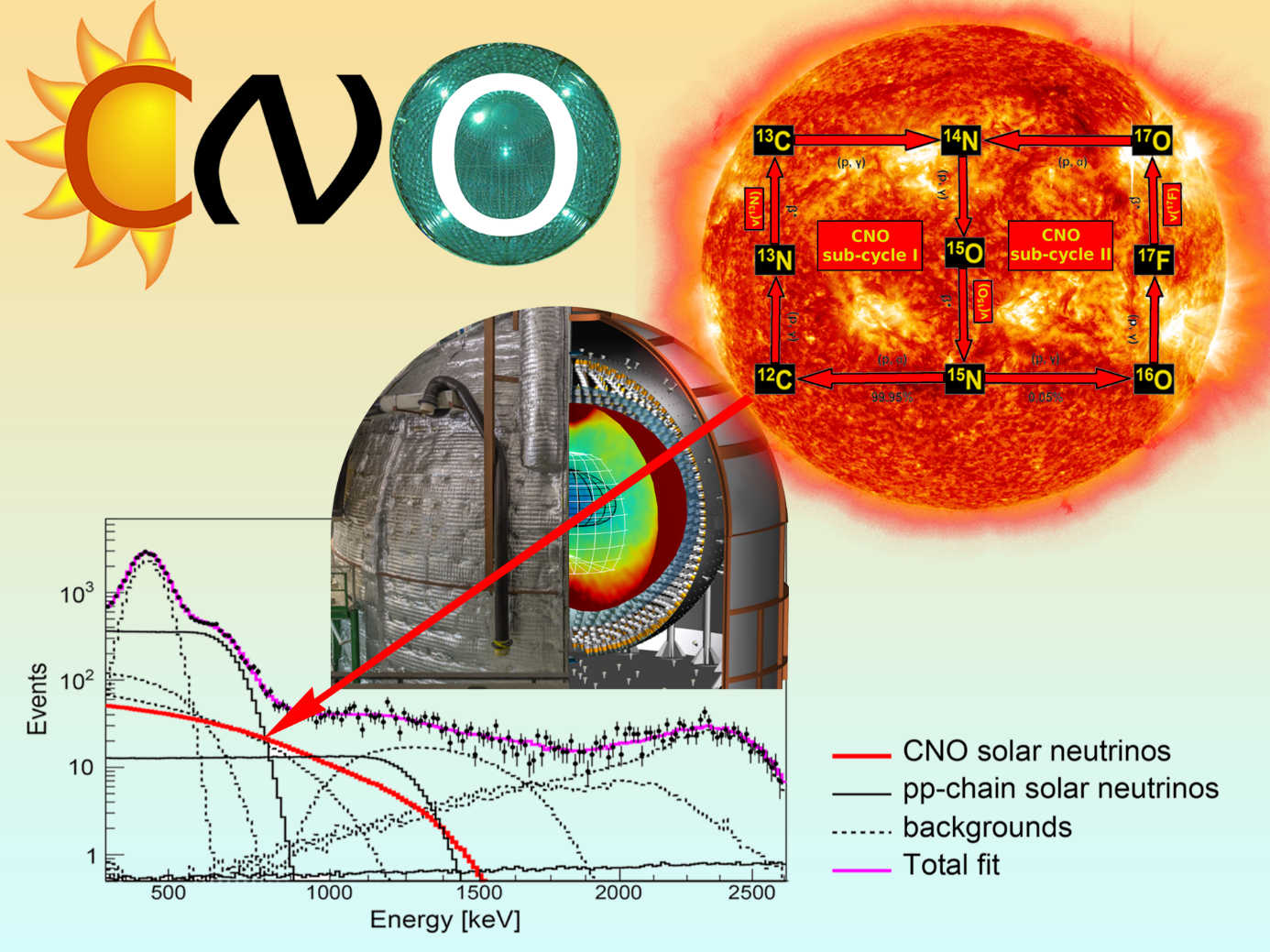A Missing Piece of the Puzzle for the Solar Engine: Discovery of the CNO Fusion
In the core of the sun, at a temperature of about 15 million degrees, hydrogen nuclei fuse together to form Helium nuclei via different chain reactions. In these nuclear processes, along with enormous amounts of energy, neutrinos are emitted as byproducts. In any given second, there are billions of solar neutrinos passing through every square centimeter on the Earth surface, carrying direct and uncompromised information about the Sun’s core. The Borexino detector, located at the Laboratori Nazionali del Gran Sasso (LNGS) in Italy, has been studying solar neutrinos since 2007. It has performed a complete neutrino spectroscopy of the so-called "pp-chain", the dominant energy producing process in our star. Now the scientists from the Borexino collaboration have for the first time observed the solar neutrinos from another fusion process, the so-called CNO cycle. This cycle, in which Carbon-Nitrogen-Oxygen catalyze the fusion, has been so far only theoretically hypothesized to contribute less than 1% of the solar energy. This discovery now confirms, with a high statistical significance of more than 5 $\sigma$, the real occurrence of this process in nature, expected to be the dominant source of energy in massive stars and thus the dominant hydrogen burning process in the whole universe. CNO neutrinos hold the key to a lot of open questions, including the abundance of heavy metals in the solar core, a burning problem in present-day solar physics.The neutrino group at the FZ Jülich Institute of Nuclear Physics (IKP) made a significant contribution to this study. The group is lead by Livia Ludhova, one of the two scientific coordinators of the Borexino collaboration, who also co-coordinated the whole CNO analysis. The IKP young scientists who intensively worked on this topic and who also co-author the scientific publication include postdocs Zara Bagdasarian and Giulio Settanta, and students enrolled at RWTH Aachen University: PhD students Alexandre Göttel, Sindhujha Kumaran, Ömer Penek, and Mariia Redchuk and a Master student Apeksha Singhal. The group contributed in a whole range of different areas of the analysis, from the data validation and selection, optimisation of the Monte Carlo simulation, preparation of the final real and Monte Carlo data sets, determination of the Bi-210 background constraint, multivariate spectral fit, systematic studies, conversion of the measured CNO interaction rate to the CNO neutrino flux on Earth, evaluation of the sensitivity to CNO neutrinos, up to the preparation of the final manuscript. The Borexino analysis group made extensive use of the computing resources of the supercomputer JURECA provided by the Jülich Supercomputing Centre. This groundbreaking discovery is the result of many years of cooperation and effort among the members of the Borexino Collaboration, who have worked hard over the years to maintain the quality of the collected data, based on the exceptional radiopurity and thermal stability of the detector.

Copyright: Borexino Collaboration, graphic of the solar flare from NASA: https://svs.gsfc.nasa.gov/11132
CNO discovery part of Physics World's top ten breakthroughs of 2020
The IKP young scientists presented the CNO results in the name of the whole Borexino collaboration at the prestigious Neutrino 2020 conference in the form of online posters presentations (also including short videos):
- Z. Bagdasarian, D. Basilico and G. Settanta: Spectral fit of Borexino Phase-III data for the detection of CNO solar neutrinos
- S. Kumaran, A. Göttel, D. Basilico, X. Ding: Extraction of Bi-210 via Po-210 for CNO neutrino detection with Borexino
- Ö. Penek: Borexino Sensitivity Studies towards Detection of Solar Neutrinos from the CNO Fusion Cycle
- Lawrence Berkeley National Laboratory Research Progress Meeting - July 16, 2020 - Berkeley, USA
Z. Bagdasarian - Invited seminar: Solar Neutrinos with Borexino> First evidence of CNO fusion cycle - The University of Sheffield - July 6, 2020 - Sheffield, UK
Z. Bagdasarian - Invited seminar: Solar Neutrinos with Borexino> First evidence of CNO fusion cycle

